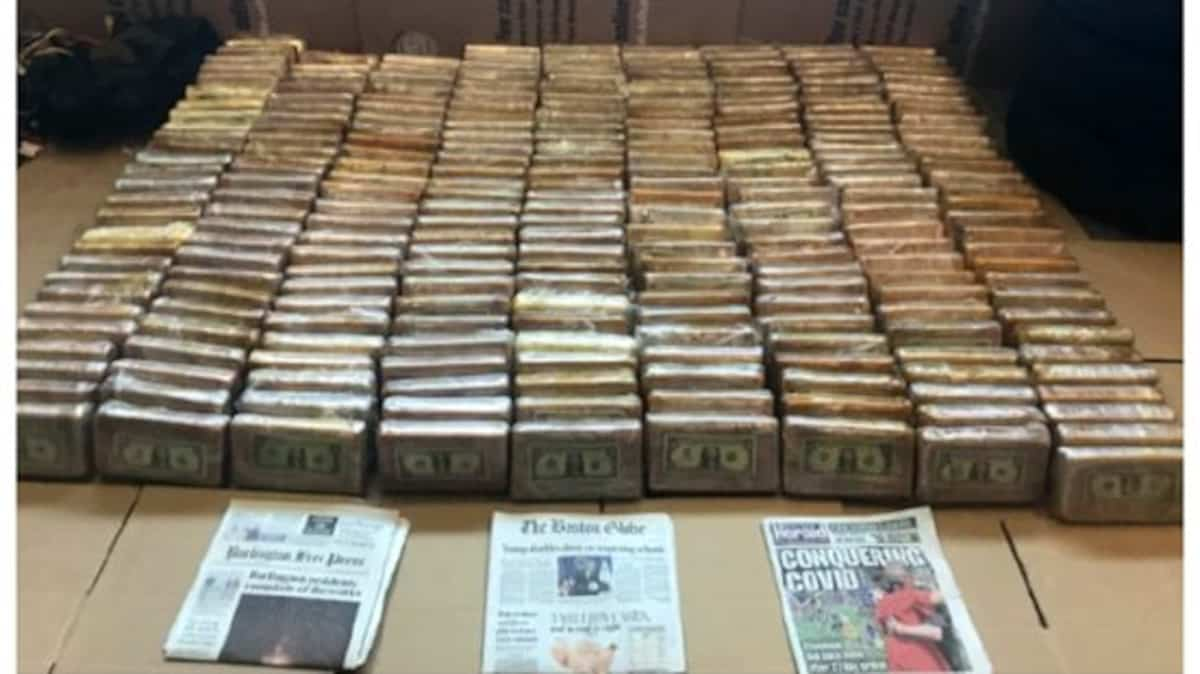Cocaine production has exploded in recent years in Peru, to the point where the small South American country is approaching Colombia for first place in the world. The JE team got exclusive access to an anti-drug operation to see how authorities were tackling the growing problem.
During our visit last May, Peruvian soldiers boarded a helicopter to neutralize the installations of a local drug trafficker.
The UH-2H aircraft from the manufacturer Bell Hélicoptère is used by teams eradicating coca fields in the Amazon jungle.
Screenshot I
The pilot had noticed a camouflaged landing strip in the jungle. These tracks are built by villagers who rent them to traffickers. A lucrative business, since each use can be worth up to $10,000.

The clandestine landing strip used by Peruvian drug traffickers is used to transport drugs to neighboring countries. The plane used to transport cocaine is visible at the end of the runway.
Screenshot I
To destroy it, the soldiers installed explosives and then pressed the detonator. Part of the dirt track erupted with a loud thud.

Colonel José Arturo Ludeña Condori (center) poses for the camera with his men as the explosion damages the runway. The Peruvian army neutralized 64 clandestine landing strips between January and September 2022.
Screenshot I
In the seconds following the explosion, Colonel José Arturo Ludeña Condori, who was in charge of the operation, proudly posed with his men in front of the explosion.
“We put pressure on traffickers, regardless of their nationality, whether they are neighbors in Colombia, Central America or even Canada and Europe,” he said in an interview with our Bureau of Investigation. .

Colonel José Arturo Ludeña Condori
Screenshot I
A large part of this drug leaves Peru by plane to go to North America, notably to Canada (see other text).
IN THE JUNGLE
When we arrived in the coca fields deserted by farmers four hours’ drive from Pucallpa, a town of 370,000 inhabitants in the Amazon, hundreds of employees were uprooting the plants. The agency they work for, CORAH, is funded by the Peruvian Interior Ministry and the U.S. government.
DRUG TRAFFICKING IN PERU
2022 review
- 95,000 hectares of coca cultivated
- Enough to export 870 tons of cocaine
- Increase of 18% compared to 2021
*Source: Peru Anti-Drug Commission
Nearby, soldiers were ready to engage in combat in the face of any form of resistance from drug traffickers.
“These are illicit crops, so it makes sense that there are very high risks. We lost a good number of workers,” says CORAH operations director Miguel Ramos Hernandez.
The teams had just received 13 million dollars from the United States in 2023. It is with these funds that we will eradicate coca plantations.
During our visit, more than 2,000 hectares of coca had already been destroyed, or 21 times the island of Montreal and enough to produce 18 tons of cocaine.
ARTISANAL LABORATORY
In the district of Monzón, on the other side of the Andes, the Peruvian National Police discovered an artisanal cocaine production laboratory. There was a maceration well and a settling well as well as numerous chemicals. This was where the coca leaf was made into coca paste and then refined into cocaine.

Clandestine laboratories are hidden under the thick plant cover of the Amazon rainforest. Several former Shining Path revolutionaries have become partners of Peruvian drug traffickers.
Screenshot I
“It is important to understand that Peru is a producing country. There is a part of the coca leaf that is used for traditional use. However, 95% is used for illicit drug trafficking,” reports Julio César Vela Uto, executive director of the CORAH organization.
Quebecers involved in trafficking
Several Quebecers have been imprisoned for having imported or attempted to import drugs from Peru.
This is the case of Georges Yaghmour, a 40-year-old man who intended to import more than 500 kg of cocaine from South America through Vermont, with Canada as his final destination.

Georges Yaghmour captured on surveillance footage at the Hilton Garden Inn in Burlington, Vermont on December 5, 2019
Courtesy photo
He was prepared to pay more than a million dollars to carry out this operation, which ultimately turned sour.
Yaghmour and his accomplices were unknowingly dealing with an undercover Drug Enforcement Administration (DEA) agent.
63 months in prison
He was arrested in 2020 and was sentenced to serve a 63-month prison sentence for conspiracy and possession to distribute cocaine. In its judgment, the court also underlined that it was “large-scale” cocaine trafficking.

Part of the cocaine seized during the investigation.
Photo Courtesy Vermont Department of Justice
Georges Yaghmour finally found freedom in November 2023 for humanitarian reasons, according to court documents consulted by our Bureau of Investigation. The Peruvian National Police have also noticed that more and more small players, including a good number of Canadians, are venturing to Peru to become drug traffickers.
In 2022, three Quebecers, nicknamed Los Nordicos, were arrested in Peru. Peruvian authorities believe that the young men were able to supply 200 kilos of white powder per month to Quebec accomplices.
Two members of the trio, Bô-Soleil Morin-Lachance and Francis Toupin-Bergevin, were released but still remain under the surveillance of authorities in Peru. Frederic Dewald is still in prison.
Some of the drugs produced in Peru travel to Canada, notably via commercial flights.

In the second basement of the Peruvian anti-drug police in the center of Lima, we find the fruit of the seizures carried out since the beginning of 2023. Several shipments of drugs were destroyed but this one was to serve as an exbibit in upcoming trials.
Screenshot I
